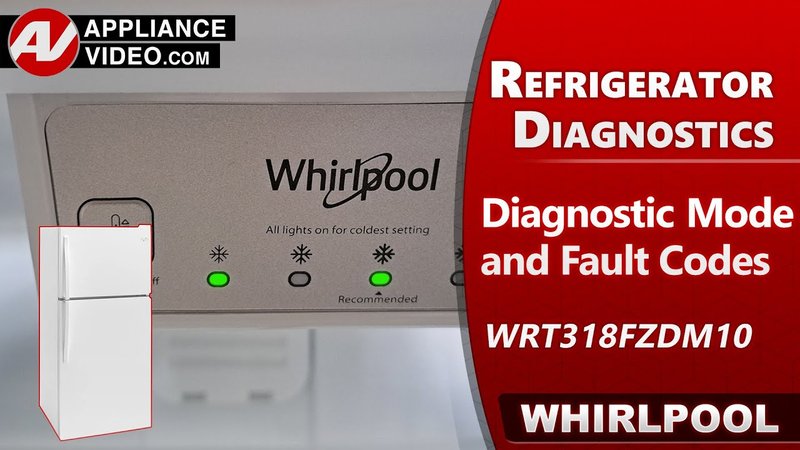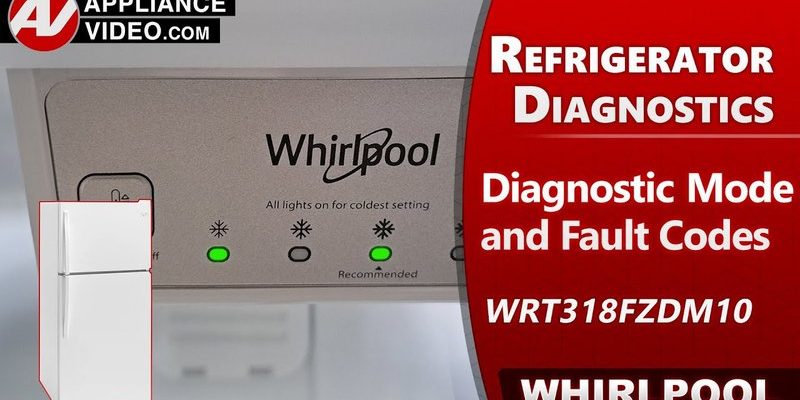
When your Whirlpool refrigerator shows the “F1” error code, it’s essentially its way of saying, “Hey, something’s not right here, and you might need to take a closer look.” This cryptic message could leave anyone scratching their head, wondering if it’s a small glitch or something more serious. Understanding what this code implies can help you determine whether it’s a DIY fix or if it’s time to call in the big guns — a technician.
Understanding the F1 Error Code
The “F1” error code usually indicates a fault related to the refrigerator’s temperature sensor. Think of the temperature sensor as the thermometer of your refrigerator. It’s like having a tiny weather reporter inside your appliance, constantly checking the climate to ensure things stay cool and fresh. When this temperature sensor isn’t working the way it should, your fridge might not maintain the proper temperature, leading to potential food spoilage or other issues.
If the sensor is faulty, it could be sending incorrect information to the fridge’s control board, which is kind of like the brain of the operation. The control board makes decisions based on the data it receives, so if it’s getting false data, it might result in the refrigerator running too cold or too warm. This is why spotting the F1 error code is important; it signals something’s amiss in this communication line.
Here’s the deal: While some might be tempted to troubleshoot this problem on their own, there are several layers to this issue that could make it tricky for beginners. Electrical components like the control board and sensors can be delicate and sometimes risky to handle without the right experience. So, knowing when to call a technician can save you time, money, and also keep your food safely chilled.
Signs You Should Call a Technician
You might be wondering, “Do I need a technician right away?” Well, let’s take a closer look at when it’s a good idea to bring in the experts. If you’ve attempted a basic reset or checked for loose connections and the code still flashes persistently, that’s a cue to seek professional help. Sometimes, a reboot might temporarily solve the issue, much like restarting your computer, but if that pesky code keeps coming back, it’s probably not a simple glitch.
Another sign to consider is the sound and temperature changes within your refrigerator. If it’s making unusual noises or if you notice it’s either too cold or not cold enough, these are red flags. It’s much like your fridge trying to tell you, “Help, I’m not feeling so well today!” Since these issues can affect food safety, it’s important to act promptly.
Moreover, if you’re not familiar with working on electrical appliances, it’s best to avoid tampering with the intricate parts inside. DIY repairs can sometimes lead to more harm than good, especially when dealing with the electrical components of a refrigerator. In these scenarios, a certified technician who understands the ins and outs of Whirlpool appliances can diagnose and fix the problem efficiently.
Potential Solutions and Alternatives
If you’re waiting for the technician or just curious about what might happen, understanding the potential solutions can be useful. The technician may first check the sensor itself, ensuring it’s properly connected and hasn’t been damaged. Think of the sensor like a tiny scout that reports back – if it’s out of commission, the whole operation could be at risk.
Sometimes, the problem lies in the control board, which might need replacement or reprogramming. Replacing these parts isn’t usually something you’d do on a whim, similar to how you wouldn’t replace the motherboard of your computer without the right skills. Additionally, technicians might inspect other parts of the cooling system to ensure everything works harmoniously.
While you wait for professional help, a good tip is to minimize opening the fridge frequently. This keeps the cold air trapped inside, much like keeping the door closed when you’re trying to keep a room warm in winter. It could help maintain a more stable temperature and prevent food spoilage. Also, ensure the vents inside aren’t blocked by food items, allowing the cool air to circulate freely.
Preventative Tips to Avoid Future Issues
You might be curious about how to prevent that sneaky F1 code from popping up again. Well, regular maintenance is key. Just like you’d take your car for an oil change, giving your refrigerator a little TLC can go a long way. Regularly cleaning the coils, which help with the cooling process, can prevent them from getting clogged and impacting performance.
Checking the door seals is also crucial; they should be tight enough to prevent warm air from seeping in. If you notice any cracks or wear, you might see an increase in energy bills due to the fridge working harder to maintain its temperature. Keep your refrigerator stocked, but not overcrowded, allowing for sufficient air circulation inside. It’s a bit like organizing a closet – too many items can make things cramped and inefficient.
Finally, schedule regular professional check-ups. Even if everything seems fine, a periodic inspection by a technician can catch issues before they escalate into major problems. This might seem like an extra step, but it’s a smart way to extend the lifespan of your refrigerator and avoid those nerve-wracking error messages in the future.
With these insights, you can better understand when to call a technician for the F1 error code on your Whirlpool refrigerator and how to manage and prevent common issues. Keeping your appliance in top shape not only ensures your food stays fresh but also brings peace of mind knowing that your trusty kitchen companion is in good working order.
